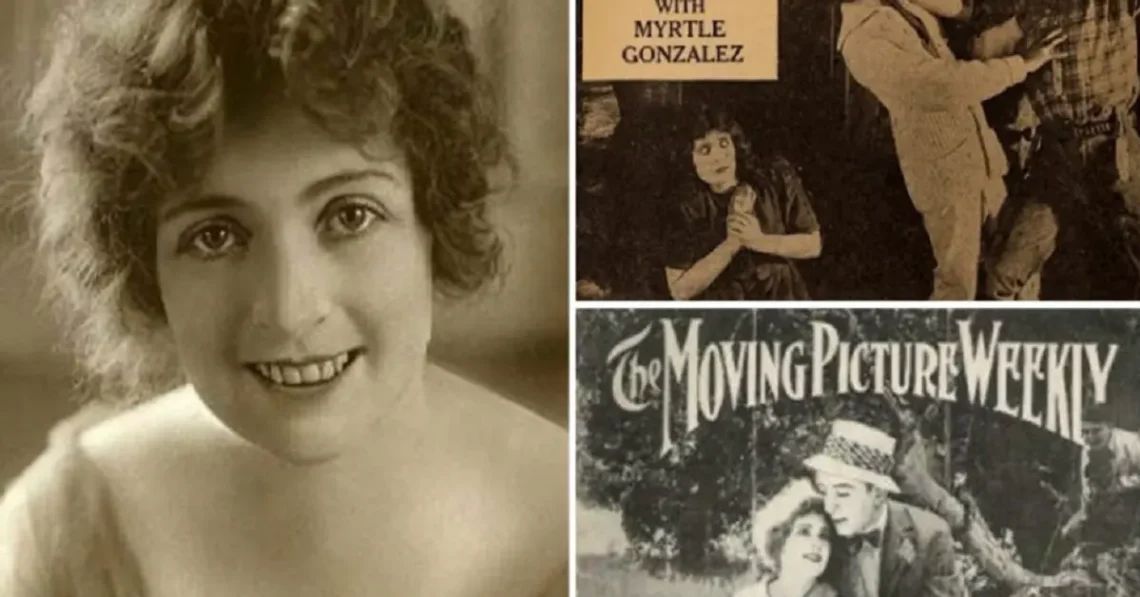Introducing Myrtle Gonzalez: Pioneer of Hollywood
Myrtle Gonzalez, renowned as the “First Latin American Movie Star,” emerged as a trailblazer during Hollywood’s formative years. Born on September 28, 1891, in Los Angeles, California, to Mexican immigrant parents, Myrtle’s journey to stardom was nothing short of remarkable.
From her early years, Myrtle displayed a keen interest in performance and entertainment. Engaging in local events, she swiftly garnered recognition for her talents, catching the eye of director Thomas Ince while performing in a local theater production.
At just 19 years old, Myrtle made her silver screen debut in the silent western film “The Invaders” (1912), marking the onset of her Hollywood career. Over the ensuing decade, she graced over 80 films, including notable works such as “The Easter Lily” (1915), “The Serpent” (1916), and “One Law for Both” (1917).
Myrtle’s allure and charisma captivated audiences, earning her widespread acclaim as one of the era’s foremost actors. Often celebrated for her charismatic comedy and charm, she was affectionately dubbed “La Unica” or “the unique one.”
Beyond her acting prowess, Myrtle was a pioneer for women in the film industry. In an era rife with gender stereotypes, she fearlessly tackled diverse roles, challenging societal norms and paving the way for future generations.
When was Myrtle Gonzalez born?
Myrtle Gonzalez was born on September 28, 1891, in Los Angeles, California.
Family
Myrtle Gonzalez was born in Los Angeles, California, on September 28, 1891, to Manuel George Gonzalez and Lillian L. Cook. Her father was a retail grocer, and her mother was a former opera and popular singer. Myrtle had two siblings, Stella M. Gonzalez and Manuel G. Gonzalez Jr.
Myrtle married James Parks Jones circa 1910. They had one son together, James Parks Jones Jr., before they divorced. In 1917, Myrtle married Allen Watt, an actor and director. They were together until Myrtle’s death in 1918.
Here is a summary of Myrtle Gonzalez’s family:
- Father: Manuel George Gonzalez (1868–1919)
- Mother: Lillian L. Cook (1874–1932)
- Siblings: Stella M. Gonzalez (1892–1965) and Manuel G. Gonzalez Jr. (1898–?)
- Husbands: James Parks Jones (circa 1910–circa 1915) and Allen Watt (1917–1918)
- Children: James Parks Jones Jr. (c. 1911–1970)
Early Life and Career Beginnings
Myrtle Gonzalez was born on September 28, 1891, in Los Angeles, California, the eldest of five children to Mexican immigrant parents, Francisco Gonzalez and Maria Rodriguez. Growing up in a multicultural neighborhood, Myrtle was exposed to various languages and lifestyles from a young age, learning Spanish from her mother and English from schoolmates.
At 14, Myrtle’s passion for acting ignited after witnessing a vaudeville show at her school. Convincing her parents to allow her to join as an assistant, she soon discovered her calling and embarked on a journey into the world of performance.
Myrtle honed her craft by performing in local theaters across Los Angeles, mastering various dance styles like flamenco and ballet along the way. In 1911, at the age of 20, she secured her first film role in D.W. Griffith’s “The Immigrant,” laying the foundation for her illustrious career.
The Rise to Silent Film Stardom
Myrtle Gonzalez, often hailed as “The Virgin of the Silver Screen,” ascended to fame in the early 1900s through her captivating performances in silent movies. Despite starting with minor roles and facing limited opportunities for Hispanic actors, her talent and determination propelled her to become one of the era’s leading actresses.
Born on September 28, 1891, in Los Angeles, California, Myrtle was raised in a multicultural environment, fostering her early interest in acting. Her graceful demeanor caught the attention of film director Mack Sennett, who offered her a chance to join Keystone Studios.
In 1913, Myrtle made her cinematic debut in the short film “Giving Them Fits,” marking the beginning of a remarkable career. Her expressive eyes and ability to convey emotion without words quickly garnered attention, leading to prominent roles in feature films like “Love’s Forgiveness” (1915) and “The Silent Witness” (1917).
However, it was her partnership with comedian Roscoe “Fatty” Arbuckle in “Fatty’s Plucky Pup” (1915) that catapulted Myrtle to household fame. Their on-screen chemistry endeared them to audiences, solidifying her status as a silent film icon.
Personal Life and Relationships
Myrtle’s personal life and relationships profoundly influenced her growth as both an actress and an individual. Born on September 28, 1891, in Los Angeles, California, to Mexican parents, she inherited a passion for performance from her family. Making her stage debut at 16, she garnered acclaim for her acting prowess before transitioning to film.
In terms of romantic relationships, Myrtle was married twice during her lifetime. Her first marriage to silent movie director George Marshall lasted six years before ending in divorce due to personal differences. In 1929, she wed film director Allen McNeil, remaining together until his passing in 1950.
Despite romantic challenges, Myrtle maintained a positive outlook and remained dedicated to her craft. Close friendships with fellow actors like Dolores Del Rio and Ramona Novarro enriched her life, while her impeccable sense of style earned her admiration as a fashion icon of the silent film era.
Legacy and Contributions to Film
Myrtle Gonzalez’s legacy continues to shape the world of film, inspiring generations of actors and actresses. As one of the first Mexican-American actresses to achieve success in Hollywood, she shattered barriers and paved the way for future Latinx performers.
Born on September 28, 1891, in Los Angeles, California, Myrtle’s early exposure to the performing arts fueled her passion for acting. Her breakthrough role in Thomas Ince’s “A War-Time Widow” (1915) propelled her to stardom, solidifying her status as one of Hollywood’s most celebrated women.
Renowned for her beauty, charisma, and versatility, Myrtle’s influence extended beyond the silver screen. She challenged traditional gender roles, bringing depth and complexity to her characters and setting new standards for female leads in cinema.
Moreover, Myrtle was a trailblazer for Latinx representation in Hollywood, breaking stereotypes and advocating for diversity in the industry. Her impact transcended borders, inspiring audiences worldwide and leaving an indelible mark on pop culture.
In Memory of Myrtle Gonzalez: Honors and Tributes
Myrtle Gonzalez, revered as the first Latin American movie star, continues to be celebrated for her contributions to cinema. Despite her untimely passing at 27, her talents were recognized with posthumous awards and accolades.
In 1919, Myrtle received the Bronze Plaque from Photoplay Magazine for her stellar performance in “The Mexican,” while Alma de Mexico magazine honored her as “the most beautiful woman in Mexico” in 1920. These awards underscore her enduring influence on American and Latin American audiences alike.
In 1960, Myrtle Gonzalez was posthumously honored with a star on the Hollywood Walk of Fame, cementing her legacy as a cinematic trailblazer. Found at 6357 Hollywood Boulevard, her star serves as a lasting tribute to her remarkable contributions to the entertainment industry.
Conclusion
In conclusion, Myrtle Gonzalez’s impact on Hollywood and the world of film is immeasurable. Despite facing numerous challenges, she persevered with determination and passion, leaving behind a legacy that continues to inspire generations of actors and actresses.
Born on September 28, 1891, in Los Angeles, California, Myrtle’s journey from local theaters to Hollywood stardom is a testament to her talent and resilience. Her groundbreaking performances and advocacy for diversity have left an indelible mark on cinema history, ensuring her place as a pioneering figure in the world of entertainment.
With her enduring legacy, Myrtle Gonzalez will forever be remembered as a trailblazer who paved the way for Latinx representation in Hollywood and reshaped the landscape of cinema.





